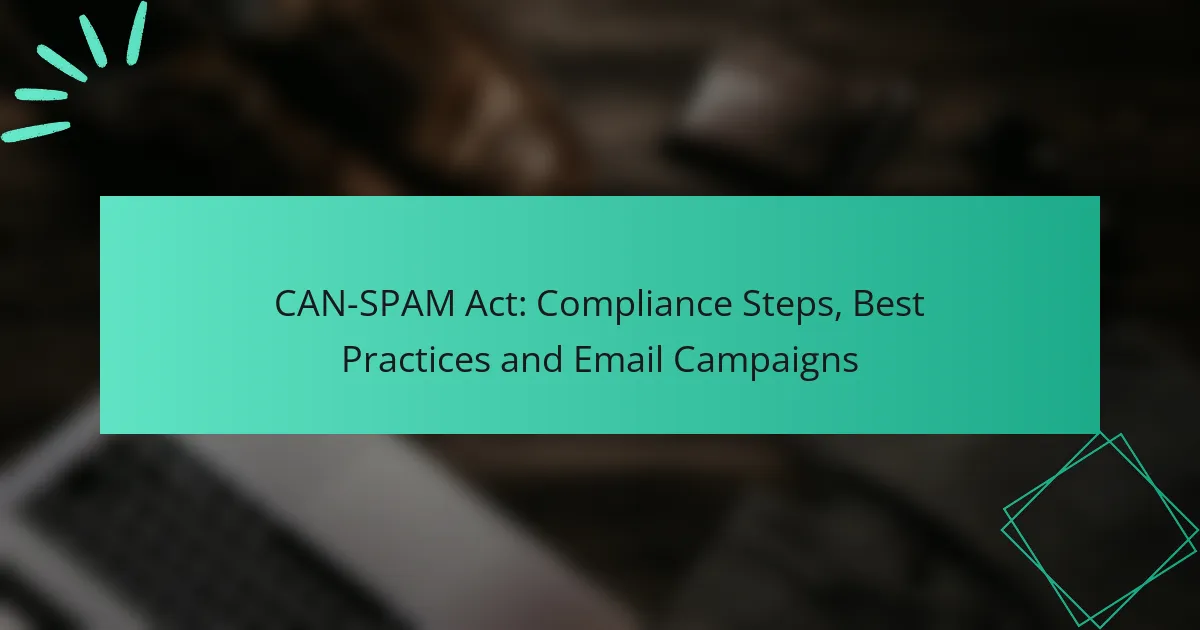Consent Management Platforms (CMPs) play a crucial role in the advertising landscape by facilitating the collection and management of user consent for data processing. They help businesses comply with regulations such as PIPEDA, GDPR, and CCPA, ensuring transparency and legal protection while enhancing user trust. By streamlining consent processes, CMPs not only simplify data management but also mitigate potential legal risks associated with data collection practices.

How do Consent Management Platforms work in Canada?
Consent Management Platforms (CMPs) in Canada facilitate the process of obtaining, managing, and documenting user consent for data collection and processing, particularly in advertising. They ensure compliance with regulations like the Personal Information Protection and Electronic Documents Act (PIPEDA) by providing users with clear options to give or withdraw consent.
Data collection and user consent
Data collection through CMPs involves capturing user consent preferences regarding personal information usage. Users are typically presented with a consent notice that outlines what data will be collected and how it will be used, allowing them to opt-in or opt-out. This transparency is crucial for building trust and ensuring compliance with Canadian privacy laws.
When implementing a CMP, businesses should ensure that the consent process is straightforward. For instance, using clear language and simple checkboxes can help users make informed choices. Regular audits of consent records are also essential to maintain compliance and address any potential issues promptly.
Integration with advertising systems
Integrating CMPs with advertising systems is vital for effective data management. CMPs can connect with various ad platforms to ensure that user consent preferences are respected during ad targeting and tracking. This integration helps advertisers avoid legal pitfalls while optimizing their campaigns based on user consent data.
When selecting a CMP, businesses should consider compatibility with their existing advertising tools. Many CMPs offer plugins or APIs that facilitate seamless integration, allowing for real-time updates of user consent status. This ensures that advertising efforts remain compliant and effective.
User interface and experience
The user interface of a CMP plays a critical role in how effectively users engage with consent options. A well-designed interface should be intuitive, allowing users to easily understand their choices regarding data sharing. Features like layered consent options can enhance user experience by providing detailed information without overwhelming them.
To improve user experience, businesses should conduct usability testing on their CMP interfaces. Gathering feedback from actual users can help identify pain points and areas for improvement. Additionally, providing clear instructions and support can further enhance user satisfaction and compliance with consent requirements.

What are the benefits of using Consent Management Platforms?
Consent Management Platforms (CMPs) offer significant advantages by facilitating user consent for data collection and processing. They enhance transparency, ensure compliance with regulations, and streamline data management processes for businesses.
Enhanced user trust and transparency
By clearly communicating how user data will be collected and used, CMPs foster trust between businesses and their customers. When users can easily understand and manage their consent preferences, they are more likely to engage positively with a brand.
For instance, a website that provides straightforward options for users to opt-in or opt-out of data collection demonstrates a commitment to transparency. This approach can lead to higher user satisfaction and loyalty.
Improved compliance with regulations
Compliance with data protection regulations, such as the GDPR in Europe or CCPA in California, is critical for businesses. CMPs help organizations adhere to these laws by ensuring that consent is obtained and documented appropriately.
Using a CMP can reduce the risk of fines and legal issues by automating consent management processes. Businesses can easily track user consent history, which is essential for regulatory audits and accountability.
Streamlined data management
CMPs simplify the management of user data by centralizing consent records and preferences. This streamlining allows businesses to efficiently handle data requests and updates, reducing administrative burdens.
Moreover, a well-implemented CMP can integrate with existing data systems, ensuring that consent preferences are respected across all platforms. This integration minimizes the chances of data misuse and enhances overall data governance.

How do Consent Management Platforms ensure compliance in advertising?
Consent Management Platforms (CMPs) ensure compliance in advertising by managing user consent for data collection and processing in accordance with regulations like GDPR and CCPA. They streamline the consent process, enabling businesses to collect, store, and manage user preferences effectively while minimizing legal risks.
Adherence to GDPR and CCPA
CMPs play a crucial role in adhering to GDPR and CCPA by providing tools for obtaining explicit consent from users before collecting their personal data. These platforms help businesses create transparent consent forms that inform users about data usage and their rights.
For example, under GDPR, users must have the option to withdraw consent at any time. CMPs facilitate this by allowing users to easily modify their preferences, ensuring ongoing compliance with these regulations.
Audit trails and reporting features
Audit trails and reporting features in CMPs are essential for demonstrating compliance with data protection laws. These features track user consent history, showing when consent was given, modified, or revoked, which is vital for regulatory audits.
Companies can generate reports to analyze consent trends, helping them understand user behavior and preferences. This data can inform marketing strategies while ensuring that all practices align with legal requirements.
Real-time consent updates
Real-time consent updates allow businesses to respond promptly to changes in user preferences. CMPs automatically adjust data processing activities based on the latest consent status, reducing the risk of non-compliance.
For instance, if a user withdraws consent, the CMP can instantly halt data collection and processing activities, ensuring that the business respects the user’s choice. This capability is crucial for maintaining trust and compliance in a dynamic regulatory environment.

What are the key features to look for in a Consent Management Platform?
A Consent Management Platform (CMP) should provide essential features that facilitate the collection, management, and compliance of user consent for data processing. Key features include user-friendly interfaces, integration capabilities, and customization options to align with your brand identity.
User-friendly consent interfaces
User-friendly consent interfaces are crucial for ensuring that users can easily understand and manage their consent preferences. A well-designed interface should present options clearly, allowing users to opt in or out without confusion. Consider platforms that offer multi-language support and accessibility features to cater to diverse audiences.
For example, a CMP might use simple toggle switches for consent options, making it intuitive for users to make choices. This can significantly enhance user trust and engagement, leading to higher consent rates.
Integration capabilities with existing tools
Integration capabilities are vital for a CMP to work seamlessly with your existing marketing and analytics tools. Look for platforms that support popular integrations with Customer Relationship Management (CRM) systems, email marketing software, and web analytics tools. This ensures that consent data flows smoothly across your tech stack.
For instance, a CMP that integrates with Google Analytics can help you track user consent alongside website performance metrics, allowing for more informed decision-making. Ensure the platform provides APIs or pre-built connectors for easy setup.
Customization options for branding
Customization options allow businesses to align the consent management experience with their brand identity. A good CMP should enable you to modify colors, logos, and messaging to reflect your brand’s voice and style. This helps maintain consistency across user touchpoints.
Consider platforms that offer templates for consent banners and pop-ups, which can be tailored to match your website’s design. This not only enhances user experience but also reinforces brand recognition, making users more likely to engage positively with consent requests.

How to choose the right Consent Management Platform for your business?
Choosing the right Consent Management Platform (CMP) involves understanding your specific business needs, compliance obligations, and the level of support you require. A well-selected CMP can streamline your consent processes and ensure adherence to regulations like GDPR or CCPA.
Assessing business needs and compliance requirements
Start by identifying your business’s unique needs, such as the types of data you collect and the regions you operate in. Different jurisdictions have varying compliance requirements, so understanding these is crucial for selecting a suitable CMP.
Consider whether you need features like user-friendly interfaces, multi-language support, or integration with existing systems. For example, if you operate in Europe, ensure the CMP can handle GDPR requirements effectively.
Evaluating vendor reputation and support
Research potential vendors to gauge their reputation in the market. Look for reviews, case studies, and testimonials from businesses similar to yours. A vendor with a solid track record is more likely to provide reliable service and support.
Assess the level of customer support offered. Effective support can be critical during implementation and ongoing use, so prioritize vendors that provide comprehensive resources, including documentation, training, and responsive customer service.
Comparing pricing models
When comparing CMPs, consider the pricing models they offer. Some vendors charge based on the number of users, while others may have flat fees or tiered pricing based on features. Determine which model aligns best with your budget and expected growth.
Be aware of any hidden costs, such as fees for additional features or support. Request detailed pricing information and consider conducting a cost-benefit analysis to ensure you select a CMP that provides value for your investment.

What are the challenges of implementing Consent Management Platforms?
Implementing Consent Management Platforms (CMPs) can be challenging due to user resistance, technical integration issues, and the need for ongoing maintenance. These hurdles can hinder effective compliance with privacy regulations and impact user experience.
User resistance to consent requests
User resistance to consent requests is a significant challenge for organizations implementing CMPs. Many users find consent pop-ups intrusive and may opt out of providing consent altogether, which can limit data collection efforts.
To mitigate this, companies should design consent requests that are clear and user-friendly. Providing concise information about the purpose of data collection can help users feel more comfortable granting consent.
Technical integration issues
Integrating CMPs with existing systems can pose technical challenges, especially for organizations with complex digital infrastructures. Compatibility issues may arise with various platforms, leading to delays and increased costs.
To address these issues, organizations should conduct thorough compatibility assessments before implementation. Collaborating with IT teams and choosing a CMP that offers robust integration support can streamline the process.
Ongoing maintenance and updates
Once a CMP is implemented, ongoing maintenance and updates are essential to ensure compliance with evolving regulations. This includes regularly reviewing consent settings and updating privacy policies as needed.
Organizations should establish a routine for auditing their CMPs and training staff on compliance requirements. Staying informed about changes in privacy laws can help prevent potential legal issues and maintain user trust.



